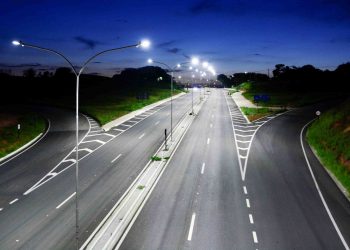
Street Lighting Projects, how to avoid common mistakes while performing them
The main function of public lighting projects is to ensure the best lighting in public spaces during nighttime to offer greater safety to the population. Brightness allows for safe traffic of people at night and allows for leisure activities for those who work during the day.
Therefore, streetlights, avenues, and walkways must provide a privileged view for pedestrians. To achieve this result, it is necessary to understand types of bulbs, radius calculation, color temperature, distance between poles, location of transformers, and many other aspects.
In this post, we will list common mistakes in public lighting projects and explain how this sector works. You will also find details about responsibilities and the importance of using technology. Keep reading!
Learn how street lighting works
In most urban centers in Brazil, brightness is provided by light poles, LED luminaires, and other devices that are part of a set. Municipal authorities work in coordination with electric power distributors to offer quality of life to citizens.
The responsibility for efficient brightness lies with the municipality of each locality. It is the municipality that contracts the service provider, in compliance with Article 30, V of the Federal Constitution of 1988, and Resolution Normative RN 414/2010, of ANEEL (National Electric Energy Agency).
The conditions for electricity supply are in its Article 18. Maintenance of lighting systems, operations, and investments are shared by regional distributors and municipalities.
For example, transformers, power grids, substations, and poles are the responsibility of essential service providers. On the other hand, relays, reactors, accessory equipment, post rods, and LED luminaires are under the care of the Municipal Public Administration.
Discover the main common mistakes in public lighting projects
Mistakes in public lighting interfere with the results of the devices, cause insecurity, and can lead to traffic accidents. Not to mention that the absence of sufficient brightness makes it possible to carry out illicit acts, as criminals lose their fear of being identified.
On the other hand, the use of conventional bulbs causes serious damage to nature due to gas emissions into the atmosphere. There are several mistakes in public lighting projects that encompass inadequate types, models, and sizes of luminaires and LED reflectors for certain locations.
See below for the faults that cause losses to public coffers, considering that they considerably increase expenses with high electricity consumption!
1. Inadequate bulb types for public lighting projects
There are several types of bulbs available in the market that can be used incorrectly by contracted companies. The Brazilian Association of Technical Standards (ABNT) has prepared the Brazilian Regulatory Standard ABNT NBR no. 5101/2018, establishing the requirements for public lighting projects and for illuminating roads, so that they provide more safety to drivers and pedestrians.
According to the text of this legislation, it can be seen that the ideal devices for generating resource savings and protecting the environment are those composed of light-emitting diodes. That is, to achieve energy efficiency, LED technology should be used.
These components can be inserted into a lighting project that aims to further improve their performance. LED reflectors and luminaires have a prolonged lifespan, lasting up to ten years, depending on the supplier and the warranty granted by manufacturers – which is at least five years.
Thus, when using this option, the public administrator needs to consider that they will have a return on their investment in the medium and long term. The devices do not require constant maintenance.
Technology
Furthermore, LED luminaires can work together with management and telegestion systems to facilitate device monitoring. This significantly reduces the need for repairs or component replacements.
Security cameras can also be installed with the equipment used in creating smart cities. Mercury vapor, sodium vapor, and metal halide lamps have several disadvantages when compared to LED devices.
They have less durability, brightness can be insufficient or too powerful and cause glare on traffic routes. LED luminaires, on the other hand, produce uniform brightness and provide up to 50% energy consumption reduction.
2. Incorrect radius calculation
When implementing public lighting projects, specialized professionals make various calculations to verify different factors. One of them is the radius calculation, which, if inadequate, impairs visibility on the streets and affects road users.
Devices cannot simply be installed without analysis and planning. Technicians evaluate the environment’s needs, pole height, power factor, luminous efficacy, operating voltage, and ideal opening angle for installation.
The insertion of components without lighting calculations causes accidents and hinders user vision.
3. Inappropriate color temperature
Lighting projects feature LED luminaires with different temperatures to meet the needs of various locations. Warm colors produce yellow light and are perfect for relaxation, as they make environments more cozy.
Cold colors, on the other hand, refer to the production of white light, which is ideal for keeping drivers alert. Therefore, devices with cold color temperature are the most suitable for illuminating streets and avenues. Each color has its function, and the LED luminaire is excellent at fulfilling its purposes.
4. Incorrect distance between poles
The installation of systems for public lighting follows determinations to ensure efficient clarity and maximum equipment performance. The average gap between poles needs to be 35 meters on public roads.
The maximum distance is 40 meters. In commercial areas and curves, structures may be separated by a smaller average gap.
5. Inadequate transformer location
The sizing and location of transformers are defined according to the area where the installation will be performed. They should not be installed in inappropriate places because they directly interfere with the capacity to distribute electrical energy.
To identify the appropriate location, the specialist evaluates circuits, environmental characteristics, network capacity, nominal power, and other determining factors.
In this article, we have seen the 5 common mistakes in public lighting projects! It is essential to consider new technologies such as LED to reduce costs with safety and maintain the energy potential of electrical networks. Another benefit is the reduction in the value of bills, which generates savings for public coffers and enables new investments!
If you are a public manager or specialized engineering professional in public lighting projects, SX Lighting is the ideal partner for the supply of high-quality and efficient LED luminaires, with a 5-year warranty and free lighting design. SX Lighting also offers LED public lighting and lighting design for condominiums and outdoor areas.
Now that you are convinced that SX Lighting will provide you with the best lighting, click here and request assistance from our specialists
Share







